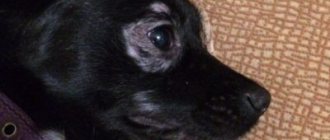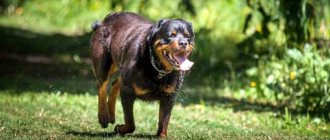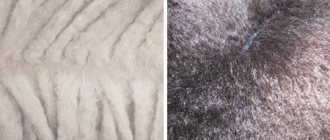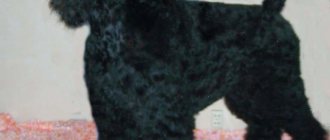A dog's coat is the first indicator of its physical health. If something is wrong with a pet’s health, we sometimes worry even more than about ourselves. Even if the dog chews out the fur, do not lose your head, remain calm, do not panic ahead of time, and we will deal with the situation together.
How to distinguish disease from molting? Many owners who have just acquired a pet and begin to notice that the fur is suddenly growing much more than usual, worry in vain and stress themselves out.
What can cause hair loss, how to diagnose the disease? We'll talk about all this.
CLASSIFICATION OF BALDING
There is no generally accepted classification system for alopecia in pets; different sources divide the types of the disease in their own way. Experts agree that canine alopecia can be divided into three types, which also have their own subtypes:
- According to etiology, they are divided into 2 subtypes: inflammatory and non-inflammatory;
- Localization classification is divided into 4 subtypes: nested, telogen, mirror or multifocal;
- Genetics: hereditary and acquired (Alopecia X).
Veterinarians use this classification of the disease to make an accurate diagnosis in accordance with the standards.
CAUSES OF ALOPECIA IN DOGS
Depending on the type of baldness, the disease can have completely different causes. The most common cause is considered to be problems with hormones, so alopecia in dogs is still conventionally divided into two subtypes: hormonal and non-hormonal. Only in 40% of cases, hair problems arise for other reasons.
Problems with hormones
According to the latest data from veterinary scientists, it has been established that hormonal hair loss in dogs is associated with genetic problems. The official name of the disease Alopecia X means that the mechanisms of development of problems and transmission through genes are not fully understood. Today, transmission through an autosomal dominant relationship is considered the most likely.
Most often, adult and elderly dogs suffer from endocrine alopecia.
Hormonal problems can be caused not only by hereditary factors, but also by acquired ones. The most common causes of hormonal problems that cause baldness are diseases such as hypothyroidism and hyperandrenocorticism. In the first case, alopecia develops due to insufficient production of thyroid hormones, in the second - increased levels of cortisol (Cushing's syndrome).
Most often, the endocrine nature of alopecia leads to baldness on the abdomen and hind limbs, chest, anus and genital area, and armpit.
Seasonal molt
Changing coats in dogs is a natural process. The condition is characterized by systematic loss of old hair at certain times of the year. Shedding usually happens twice a year, but there are breeds in which it happens a little more often. It is easy to distinguish seasonal molting from pathological baldness by characteristic signs:
- Uniform hair loss without bald spots or bald spots;
- After combing, you can notice better quality wool of shorter length;
- Seasonality - loss occurs in spring and autumn;
- The dog's behavior has not changed.
When changing coat, the dog may itch a little; it is important not to confuse this symptom with the appearance of itching from other diseases. This process can be accelerated by systematically brushing the coat every day during the molting period.
Poor nutrition
The cause of pet baldness can be an unbalanced diet with a lack of vitamins and minerals. Most often, coat problems appear in dogs that eat monotonous natural food. For healthy hair growth, the animal's body needs vitamins B and C.
Dogs that consume dry or canned food do not experience problems with hair loss due to a lack of vitamins. Typically, such feeding is saturated with useful substances.
Baldness after grooming
Dogs with hair growth problems experience problems with hair growth after clipping. In fact, slow coat growth is the first sign of accumulated problems. In this case, you need to contact a veterinary clinic and have your pet examined. The doctor will find out whether the lack of new hair is normal or a disease. If health problems are identified, it is necessary to change the animal’s diet and administer medication.
Allergic reactions
Allergic dogs suffer from patchy baldness due to the severe itching that accompanies the disease. The animal scratches the area of discomfort until bald patches appear. In this case, baldness is not due to hair growth problems, but is a secondary symptom of an allergy.
Allergies can be caused by food, pet care products, clothing materials, or seasonally flowering plants. In this case, the allergy is characterized by redness of the skin, and sometimes open wounds at the sites of irritation. The skin becomes dry and dandruff appears. It is difficult to identify the cause of an allergic reaction; you will need the help of a specialist.
Parasites, Demodicosis
The presence of harmful parasites in the body often leads to thinning and hair loss in dogs. Alopecia develops as a consequence of helminthiasis, demodicosis, otodectosis or sarcoptic mange. In this case, parasites can be found both on the skin of the animal and in the internal organs.
Parasitic diseases lead to a general deterioration in the health of hair follicles. Often parasites lead to severe itching on the dog's skin. The pet begins to itch a lot and symptoms of alopecia areata appear.
Stress
Dogs, like people, can experience stress; Chihuahuas and Labradors are most susceptible to such disorders. As a result of stressful situations, the animal's body experiences a multicomponent reaction in response to severe stress. Scientists have proven that this condition of the animal can lead to hair loss, among other things (Yang EV, Glaser R., 2001). The causes of stress are:
- Moving;
- First visit to exhibitions and competitions;
- Aggression from humans or other dogs;
As a result of stressful situations, the mildest form of alopecia develops - diffuse. Symptoms of the disease may not be noticeable and everything will return to normal on its own. Complications can arise if the pet experiences stress very often.
Special grooming procedures
Properly selected vitamin and mineral complexes and nutritional supplements can reduce the duration and intensity of the seasonal process. If they do not have a noticeable effect, you should consult a veterinarian. He will tell you what to do when your dog sheds heavily. You can also use grooming services.
Express molt
Professionally performed combing is called express shedding. It is carried out by a master in a hairdressing salon for animals, that is, in a grooming salon.
Express shedding includes brushing with a furminator brush, bathing with shampoo and conditioner, and drying with a special hairdryer. The procedure makes it possible to remove up to 90% of dead hair, and the effect lasts up to 3 months.
Trimming
Removing dead hair by plucking is called trimming. This is a health and hygiene procedure carried out in the salon. Trimming is recommended for wire-haired breeds (listed above), which find it difficult to shed dead particles on their own. A salon procedure is performed on average once a quarter, which allows you to maintain a neat appearance for your pet.
Demodicosis as a cause of alopecia
Endoparasitism has made mites of the genus Demodex of the family Demodicidae so small that they cannot be seen with the naked eye. Demodex live in the sebaceous glands and hair follicles of mammals. Young adult ticks go through a phase of cutaneous existence. Then they spread the population throughout all the productive sebaceous glands of the “host”.
The genus Demodex is divided into species depending on its preferred host. There are 3 types of dogs to choose from. The most common follicular mite, Demodex canis, is aggressive. Causes red iron (iron scabies, demodicosis) - a severe, very itchy, torpid (little sensitive) to therapy and sometimes fatal disease.
Demodex itself is not a particularly harmful parasite; its presence on the skin is not a disease. Cohabitation with Demodex canis is harmless to the dog. But if the irritation from the waste products of the tick is layered on the skin manifestations of any disease, it will greatly complicate it.
SYMPTOMS OF ALOPECIA IN DOGS
Each type of alopecia has its own characteristics, and there is no single clinical symptomatology. Depending on the cause and type of hair loss, dogs suffer from the following symptoms:
- Baldness due to hormonal imbalance is characterized by uniform or focal hair loss, as well as hyperpigmentation (Alopecia X).
- Seasonal shedding is characterized by uniform thinning and hair loss, but not completely.
- An unbalanced diet leads to alopecia in the form of severe thinning of the coat.
- After grooming, the symptom will be that the coat does not recover for a month.
- Allergies are characterized by alopecia areata, sores and redness in areas of baldness.
- Parasitic baldness manifests itself focally, the dog makes bald patches by scratching.
- Stress baldness is characterized by uniform loss and thinning of a dog's hair.
- During pregnancy, hair falls out evenly and the hair becomes thin. After childbirth, the fur is gradually restored.
Differential diagnosis based on the symptoms of alopecia is impossible; to determine the causes and type of disease, you need to contact a veterinary clinic where research will be carried out.
Vitamin complexes for dachshunds
The issue of vitamins is controversial, since with proper nutrition, all components are supplied to the dog in the required quantities. Vitamins are given according to the dog’s condition, for example, if the dog’s hair is falling out or the animal is lethargic, strengthening vitamin complexes can be administered. If the dog does not have a genetic defect, then the coat is shiny and beautiful. Dry skin, clouded vision and slow growth indicate a lack of vitamin A in the diet. Liver in the diet will solve this problem. Hair loss is indicated by a lack of vitamin B. This vitamin makes the color expressive and bright. If the dog’s appetite has disappeared and the dog has become lethargic, it is necessary to introduce vitamin C into the diet. Vitamin D is useful for bones, and if the dog begins to chew plaster and lick whitewash, then calcium is introduced. The dog's condition should be monitored closely; some signs of appearance and behavior indicate the appearance of serious diseases.
BEST TREATMENT METHODS
Based on the diagnostic results, the veterinarian must prescribe appropriate treatment for the dog. There are general recommendations that are aimed at stimulating hair growth in dogs:
- Give the dog stimulating vitamins (Velkot, Polidex Super Wool);
- Increase the frequency of bathing your pet up to once a week;
- Masks of castor and burdock oil with egg yolks.
- Biopsy;
- Phototrichogram;
- Glow with an ultraviolet lamp;
- Biochemical, mycological and bacteriological studies of skin scrapings;
- General analysis of blood, urine and feces.
DO NOT give your dog human medications to stimulate hair growth (such as Minoxidil). The consequences of using such drugs can lead to the death of the animal.
After poor nutrition
Alopecia after an unbalanced diet requires a gradual increase in nutrients in the diet. Veterinarians recommend starting to give your dog fish oil, dairy products, seafood, and adding olive and flaxseed oil to his food. Vitamin complexes containing vitamin A can also be prescribed.
Treatment of hereditary hormonal alopecia
A genetic predisposition to baldness is formed due to hormonal problems. Therapy is carried out accordingly with hormones. The effectiveness of this therapy is low, so it is used in combination with the use of hair growth stimulating agents.
Contact or food dermatitis
This type of alopecia has an allergic etiology and side effects. It is treated with a complex of drugs prescribed by a veterinarian:
- Antihistamines (Diazolin, Diphenhydramine, Suprastin);
- Antiseptic ointments (Ranosan, Saphroderm, Septogel);
- Eliminating the allergen.
The use of such a complex of therapeutic measures helps eliminate the symptoms of baldness after 2-3 weeks. In advanced cases, independent treatment is impossible; the dog remains in the hospital.
Treatment for hair loss due to infection
The treatment regimen depends entirely on the type of infection that led to baldness. First of all, treatment is aimed at eliminating foreign bacteria, fungi and viruses from the body. Treatment is carried out with antiviral drugs.
Melatonin is a hormone synthesized in the pineal gland, primarily at night, and is the product of the multistep conversion of L-tryptophan to serotonin and then to melatonin. In many vertebrates, it is involved in the regulation of a wide range of physiological and behavioral processes. This includes modulation of reproduction, especially in those animal species whose reproduction depends on the seasons; photoreception; thermoregulation; coloration of the skin and coat, as well as the color and growth cycles of the coat. In the course of clinical and fundamental studies of the effect of melatonin on the human body, its anti-aging, antioxidant properties (its ability to absorb free radicals, more powerful than that of vitamin E), oncostatic properties, use for sleep disorders, depression, and as part of contraceptive drugs were studied.
The most information about melatonin has been obtained over the past two decades. Due to the wide range of possible actions of melatonin, it appears in many literature sources; in the Medline text editor, the word “melatonin” has over 3,000 citations to published articles ranging from the late 1980s to the late 1990s. However, melatonin is rarely mentioned in the dermatological humane medical literature. This is surprising considering that the hormone was first isolated from the pineal gland of cattle in 1958 by Dr. Aaron Lerner, a dermatologist who studied its effects on skin pigmentation. Although melatonin causes skin lightening in amphibian frogs (due to rapid melanosomal aggregation around the core of dermal melanocytes) and is responsible for the growth of white winter fur in weasels and Siberian hamsters (possibly due to its antimelanocyte-stimulating hormonal action), it does not play an important role in skin pigmentation in humans. Currently, in humane medicine, the oncostatic properties of melatonin in cancer patients, especially melanoma, are being actively studied. There is evidence of increased survival in melanoma patients treated with interleukin-2 (IL-2) plus melatonin compared with patients treated with IL-2 alone. In addition, advanced solid tumors that were unresponsive to IL-2 treatment responded to IL-2 treatment with concomitant administration of melatonin, which enhanced the antitumor immune effects of IL-2 or the susceptibility of cancer cells to cytolysis mediated by IL-2-induced cytotoxic lymphocytes, or both.
It has been suggested that in the 20th century, increased daily exposure of the retina to artificial light, unlike in previous times, led to a decrease in the release of melatonin, which in turn contributed to an increase in the incidence of melanoma and other cancers.
Melatonin has received little attention in veterinary dermatology. This substance exerts neuroendocrine control over photoperiod-dependent molting or fur coloration in many mammals. However, the mechanism by which melatonin causes shedding and fur growth is not fully understood. This hormone acts directly on the hair follicles or within the central nervous system to alter the release of melanocyte-stimulating hormone or the release of prolactin, or both.
The effect of melatonin on fur growth has been studied in minks and foxes. There is evidence of a synergistic effect of prolactin and melatonin, two photosensitive hormones, at the level of the hair follicle. The release of melatonin is inversely proportional to the duration of daylight hours, and the concentration of melatonin in the blood is inversely proportional to the content of prolactin. Melatonin is released in the dark, so the amount of melatonin biosynthesis is directly proportional to the duration of the dark night hours. Its quantity continues to grow in the fall until the winter solstice.
Minks exhibit seasonal fur growth, which is regulated by photoperiod. As the length of the photoperiod decreases, the amount of melatonin increases (and prolactin decreases), which causes the growth of winter wool, which begins in September in northern latitudes. In spring, the opposite happens: the length of the photoperiod increases, leading to an increase in the amount of prolactin (and a drop in melatonin), causing spring molting. In minks treated with melatonin implants in June when natural production is low, or exposed to an artificial 6L:18D photoperiod, or treated with the dopamine agonist bromocriptine, prolactin production was suppressed, fall molting began early, and the first winter fur appeared by mid-October. 6-8 weeks earlier than usual. For this reason, melatonin implants have been supplied ready-made to the fur industry for several years for use in minks and foxes. This is the best of all that the author knows on this issue, the only use of ready-made melatonin in veterinary dermatology. However, melatonin was also used in the 1960s to treat acanthosis nigricans in dogs. It has recently been used experimentally in dogs with recurrent lateral alopecia, common alopecia, and alopecia-X in Nordic breeds.
Raising and training a smooth-haired dachshund
The dachshund has an innate intelligence; it remembers commands quickly and is easy to train. Training is based on an unconditioned reflex and mechanical influence. Commands must be clear and precise in an orderly tone, no persuasion. The training scheme is simple: give a command, mechanically influence, give a treat as a reward. A treat is given only when the command is completed correctly. Two teams will knock down a dog; demand one thing from the dog at a time. When choosing a collar, pay attention to a soft leather one; it is reliable and will not put too much pressure on your neck, unlike a metal one. If there is a thickening on the collar, then such a collar will not rub the neck and will not twist during a walk.
Recurrent alopecia of the lateral surface of the body in dogs
Clinical characteristics Canine recurrent flank alopecia (CRFA) is a skin disease of unknown origin, characterized by episodic body hair loss and often relapsing in nature. Previously, it had the following synonymous names: seasonal lateral body alopecia, seasonal growth hormone deficiency, idiopathic cyclic alopecia of the lateral body in dogs, cyclic follicular dysplasia and follicular dysplasia. CRFA is most common in dog breeds such as Boxers, Bulldogs, and Airedale Terriers, but is sometimes seen in other dog breeds. The disease can occur in animals of any gender and reproductive status. CRFA is characterized by non-scarring alopecia, which is most often concentrated in the thoracolumbar region. The lesions are usually symmetrical and bilateral, but occasionally dogs may only have one side of the body affected, or one side may be more affected than the other. Lesions caused by alopecia are ring-shaped or "geographic" in shape with well-demarcated edges. The skin is characterized by noticeable hyperpigmentation. The average age for the onset of alopecia is 3 to 8 years, but it varies (ranging from 8 months to 11 years). The onset of alopecia in males is not limited to the autumn and winter months; there is evidence of spring alopecia in females as well. And yet, if all cases are collected, in the Northern Hemisphere in most dogs the onset of alopecia occurs from November to March. The month of onset of clinical signs of alopecia does not depend on breed, age, gender or sexual status.
In many cases, spontaneous hair regrowth occurs within 3-8 months, and the coat is usually thick, although some dogs may grow darker hair on previously affected areas of the body (especially Boxers) or may have a golden-colored coat (aurotrichia). ), which is observed in some miniature schnauzers. But after several consecutive cases of alopecia, some affected dogs no longer regain full hair growth until the next episode of alopecia occurs. In the experience of the author of this article, approximately 20% of these dogs have had only one case of lateral alopecia in their lifetime. However, most dogs have had recurrent cases of alopecia over a number of years. In other dogs, a year has sometimes passed without recurrence of alopecia. The degree of alopecia varies; Some dogs lose the same amount of hair (in size and duration) from year to year, while others have larger areas of skin affected each year, or hair loss lasts longer, or both.
Causes and Pathogenesis The etiology of CRFA remains unclear. To date, the underlying causes, such as endocrinopathies, have not been confirmed. The seasonal nature and recurrence of CRFA suggest that the process is dependent on photoperiod. According to the author, CRFA occurs more often at higher latitudes (i.e., north of the 45th parallel). This suggests that CRFA may actually be caused at the genetic level by melatonin deficiency, which directly or indirectly (through its action on prolactin, androgen, estrogen or growth hormone, or a combination of all three) causes relapses of alopecia.
Treatment Although some drugs are mistakenly believed to be effective in treating CRFA, no treatment has yet been found to be effective. However, melatonin shows promise in the treatment of CRFA, as initial treatment trials have shown encouraging results. However, the unpredictable course of CRFA and spontaneous hair regrowth make the evaluation of any anti-CRFA therapeutic agent used to either prevent or reduce alopecia extremely difficult. Our only subjective knowledge is that a dog that has had three consecutive cases of CRFA has a high probability (>80% of cases) of recurrent alopecia in the following year.
The original trial, conducted to evaluate the effectiveness of melatonin in preventing the onset of CRFA, involved nine dogs that had previously had three or more recurrent episodes of CRFA (Paradis, 1995). Around the autumnal equinox (about two months before the next "expected" CRFA outbreak), each dog was given melatonin: three dogs received two subcutaneous injections of 12.5 mg melatonin in soybean oil (2.5 mg/ml; this formula is not commercially available form) at 2-week intervals, and six dogs were given three long-acting implants containing 12 mg melatonin subcutaneously (36 mg total, based on a 12 mg dose per fox). None of the dogs treated with melatonin in the fall had large patches of alopecia in the winter after melatonin treatment, as in previous years. Instead, two (large male Airedale Terriers) had discrete patches of hypotrichosis, 1.5-2 cm in diameter, that lasted less than a month and were quite different from the previous extensive patches of alopecia that typically lasted several months. In one old Boxer bitch who had had six consecutive cases of alopecia and had not completely recovered from the recent episode, there was no regrowth of hair in the relatively small area of alopecia that remained after administration of melatonin, but no new areas of alopecia appeared. It is also of interest that some dog owners reported that their pets began to grow thicker hair than usual after melatonin administration.
Since this initial study, some veterinary dermatologists have used melatonin in CRFA to either prevent recurrence or shorten the duration of an alopecia outbreak. In several cases, clear improvements have been achieved with either oral melatonin (tablets or capsules) or subcutaneous melatonin (water injections or implants). To document a true benefit of melatonin treatment for this disorder, dogs must be selectively treated before or immediately after the onset of alopecia (although the use of melatonin as a preventative treatment is limited given the 60-70% chance of relapse in any given year). A double-blind, placebo-controlled study is needed using oral melatonin as an alternative treatment for many animals with these clinical signs.
Structural alopecia in dogs
Clinical signs Structural alopecia in dogs (SCA) is a fairly common but poorly understood disease. There are three different syndromes observed in dogs. The most common syndrome usually consists of acquired alopecia, which forms behind the ears; along the ventral part of the neck, chest and abdomen; and on the caudomedial part of the thighs. This alopecia is observed mainly in dachshunds, but also occurs in some dogs of short-haired breeds: Chi Hua Hua, Miniature Pinscher, Whippet, Greyhound, Boston Terrier, Boxer, etc. Hair loss usually begins at around 6 months and gradually progresses over the next year, but does not extend beyond the areas described above.
Treatment Since RSV is purely an aesthetic problem, little effort is spent on finding possible treatments for this pathology. The author has no data on the availability of effective treatment for RTS, other than the possible effectiveness of melatonin. Indeed, in a study conducted by the present author evaluating the effectiveness of melatonin in CRFA, two boxers with concomitant CRFA experienced significant hair growth in areas where hair had previously been sparse or absent (most commonly the chest and ventral neck areas). ). Based on these unexpected findings, a pilot study was conducted to evaluate the effectiveness of melatonin in the treatment of SAD in dogs (Paradis, 1996).
Eleven purebred dogs with RTS described above were treated with SC administration of either 1–3 long-acting implants containing 12 mg melatonin (7 dogs) or SC administration of melatonin capsules containing 5 mg lactose-based melatonin, according to one every 24 hours for 30 days (4 dogs). All 11 dogs experienced slight to significant hair growth on the affected areas, which was noticed 1.5 months after the start of treatment. Maximum fur growth was observed after 3-4 months. Most pet owners were satisfied with the results, and some reported a thicker, more beautiful coat. In the two dachshunds and two miniature pinschers tested, the results were less impressive, and in all dogs there was little hair growth in the dewlap area, possibly due to premature shedding or irreversible follicular atrophy.
Since this initial study, some veterinary dermatologists have treated other cases of RTS with melatonin. Several dogs have had positive results (but not all), including dachshunds and Boston terriers.
Wool
Smooth-haired dachshunds do not require special coat care; it is enough to wipe the pet with a terry towel, while long-haired and wire-haired dachshunds need to be brushed. Long-haired dogs need to be brushed approximately 3 times a week. First, comb the fur with a wide-toothed brush, then with a fine-toothed brush. The hair of long-haired dachshunds can be plucked by hand, using light tweezers to remove dead hair.
Dachshunds like to be stroked, their fur pulled, and massaged. Such actions have a positive effect on the condition of the coat.
In case of infestation with fleas, ticks or for prevention, use flea talc, anti-flea collars, drops or special anti-tick sprays. The choice of drug depends on the dog’s age, tendency to allergic reactions, and coat type.
The fur on the paws should be trimmed regularly, because... Dirt and bacteria can accumulate in it. The optimal coat length is 1-2 mm. from under the pillows.
If the wool is very dirty, you can simply rinse it under a warm shower without using shampoo.
Alopecia-X in Scandinavian breeds
This is what some veterinary dermatologists call the following diseases:
- false Cushing's syndrome;
- growth hormone deficiency that appears in adulthood;
- hyposomatotrophism in adult dogs;
- growth hormone sensitive alopecia;
- castration sensitive dermatosis;
- dermatoses caused by gonadal sex hormones;
- dermatosis caused by sex hormone or growth hormone;
- biopsy sensitive alopecia;
- disturbance of adrenal sex hormones;
- congenital adrenal hyperplasia-like syndrome;
- dermatosis sensitive to lysodren;
- follicular dysplasia in Scandinavian dog breeds;
- follicular dysplasia in Siberian huskies;
- follicular growth dysfunction in breeds with plush coat texture, etc.
Some veterinary dermatologists have treated many animals with this condition with melatonin, and the treatment has had clear success in more than 50% of cases. However, no specific criteria have been established regarding any breed, sex, age, etc.
Source of melatonin
Melatonin is easily synthesized and is therefore a fairly inexpensive hormone that is administered orally (as tablets or capsules) or systemically using subcutaneous injections or long-acting subcutaneous implants. Interestingly, melatonin is also present naturally in some plants. However, to absorb 3 mg of melatonin, you would need to eat 120 bananas or 30 large bowls of rice!
Melatonin tablets are sold over the counter in pharmacies and health products in the United States and some other countries, where it is considered more of a dietary supplement than a drug (so it is not regulated as such). Melatonin is available in 2 or 3 mg tablets under several trade names. However, only licensed products guarantee quality. Melatonin crystal powder is also made into capsules. The main problem with oral melatonin is its short half-life and dose-dependent bioavailability. In one study, after administration of 3 mg/kg IV, its half-life in dogs was 18.6 minutes. Thanks to the Rickards Research Foundation, injectable liquid melatonin (made from crystalline melatonin powder dissolved in ethanol and mixed with water and DMSO) has been available for several years. It has been used in the past to treat acanthosis nigricans (Scott et al., 1995). This could be a valuable option, although pharmacokinetic data on this are lacking. Long-acting implants containing 2.5 mg and 12 mg melatonin have been approved in several countries for use in mink and foxes, respectively. They are produced by WildlifePharmaceuticals. Unfortunately, some dogs that have received subcutaneous implants have developed sterile abscesses or granulomas at the implantation site. This is common in dogs; In the fur industry, more than 10 million minks and foxes received subcutaneous melatonin implants and there was no evidence of local adverse reactions.
Parameters of the smooth-haired dachshund
The dog's body is elongated and squat, its legs are short and powerful, which is convenient for movement, the muscular system is well developed, the dog is nimble, agile and flexible, ready to crawl through even a narrow hole. The dachshund's head is elongated with an elongated muzzle, which is not pointed. Smooth jaws with 42 teeth have a strong grip. The eyes are clear, round and have a friendly look. The ears are of medium length, the tips reaching the cheekbone. The belly is tucked, and the body is graceful and each part of it flows smoothly into another, for example, the neck to the body. The limbs make up one third of the dog's height at the withers. The coat of the smooth-haired dachshund is very coarse and the hairs are densely packed. These parameters represent the general appearance and type of constitution of the smooth-haired dachshund.
Clinical uses of melatonin
At this time, the use of melatonin in dogs should be considered experimental. There have been no reports of possible adverse long-term side effects in dogs or other animal species. After human volunteers were given 6 grams (6,000 mg) of melatonin every evening for 30 days, the only side effects noted were stomach discomfort and some drowsiness. Since melatonin has been shown to regulate light-induced reproduction in mammals, it is best not given to dogs that are about to breed. However, since CRFA, CRF and Alopecia-X in Scandinavian breeds are most likely genetically programmed, it is best to try to avoid using these dogs in breeding programs. Because melatonin is a valuable treatment for some types of alopecia in dogs, its long-term effects should be evaluated. Hundreds of questions remain. What is the optimal dose and route of administration, duration of treatment, and best time of year (or time of day if administered orally) to begin treatment? It is unknown whether its effectiveness depends on the duration of use, the high concentration, or only on the maximum amount of melatonin produced at the initial stage. We also do not know the minimum number of days in which melatonin is present for hair growth to begin. Finally, it is also unknown whether a given animal is desensitized or intractable to a previously induced signal after a prolonged period of exposure to high concentrations of melatonin.
Studies are needed to confirm the results of these preliminary trials of the effectiveness of melatonin treatment for various types of alopecia in dogs. In the meantime, if it is necessary to try melatonin in dogs with alopecia, the author recommends the following: Administer one to four 12-mg subcutaneous implants per dog. This is purely empirical data based on a dose of 12 mg per fox producing early winter fur growth in this species. This drug has the advantage of prolonged action, which is important for its therapeutic effectiveness. Melatonin is administered to foxes over several months, so it can be administered once (CRFA) or twice (CPA) per year depending on the type of disorder. If implants are not suitable, po melatonin can be used, given daily for 4-6 weeks at the highest possible dose and as often as possible (eg, 3-6 mg every 8-12 hours). Later it may turn out that this treatment regimen is too intense in its dose and duration. However, the above recommendations are based on the short half-life of orally administered melatonin in dogs and the knowledge that in minks, hair follicle activation by melatonin occurs over a 4-6 week period. This photoperiodic impulse obviously does not have much significance for the further growth and maturation of hair. ATTENTION! Melatonin is considered a safe drug, but pet owners should be aware of the experimental nature of the treatment and sign the appropriate form.
Therapy for baldness from parasites
Treatment is aimed at eliminating helminths from the pet’s body that cause coat problems. Antiseptics are used to eliminate itching and prevent scratching. Further treatment is carried out using antiparasitic agents for animals, bathing, and enemas.
READ: Enteritis in dogs, treatment and diagnosis of enteritis!
Diet
It is worth carefully reviewing the food your dog receives daily. If your diet contains a large amount of sweets and fatty foods, you shouldn’t even dream of a shiny coat. In addition, eating “human food” (table food) will have a negative impact on your pet’s overall health.
Based on the information above, we can come to the conclusion that a dog needs fur not for beauty, but for protection in bad weather and to prevent various diseases.
Sources:
https://badgerdog.ru/page/vypadaet-sherst-u-taksy-1-esli-vypadaet-sherst-u-sobaki https://v-mire-sobak.ru/porody-sobak/taksa/uhod-za -taksoj.html https://www.8lap.ru/section/vopros-o-sobakakh/chto-delat-esli-u-taksy-vypadaet-sherst/










